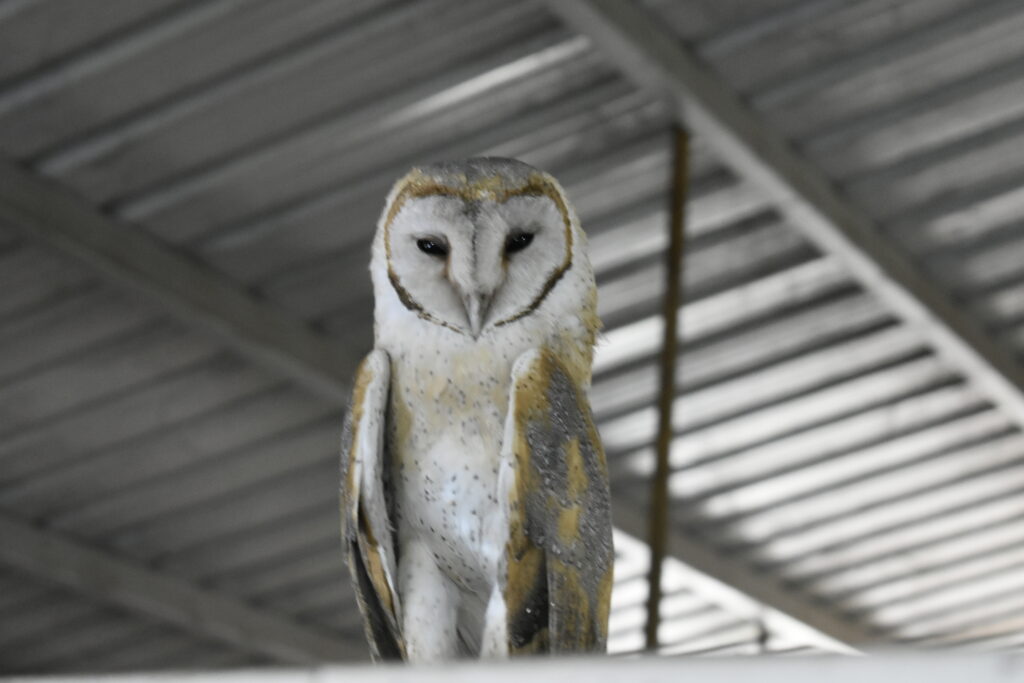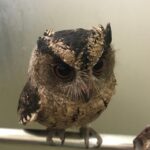Owls have made frequent appearances at K’sirs. I recall my first encounter with an owl — or rather, two young Indian Eagle Owls — back in 2018. The two owlets were not more than a few months old when I caught sight of them perched on a tree branch outside my classroom window. They looked frail and vulnerable. After realising that they were suffering from malnutrition, some of my seniors teamed up to rescue them.
Over the following months, they cared for the owlet that survived. They had an unforgettable experience, but that’s a story for another day. (Feel free to check out their old blog post on their Avian Adventure.) Today, I want to tell you about our newest guest: a stunning Barn Owl.
It was a typical afternoon when the news broke: a new arrival had graced us with its presence. K’sirians from all grades flocked, whispering in awe and eager to get a glimpse of the mystical creature. Our student photographer, a friend of mine, raced over to capture the moment, and what he saw was even more spellbinding. The Barn Owl sat so still, so peaceful, gazing intently at the camera, almost as if she knew she was being photographed and was posing.
We couldn’t help but feel like she was just as excited to see us as we were to see her!

As soon as my friends and I caught sight of her, we felt like we’d been transported into the pages of a Harry Potter novel. We discovered our guest was a female based on her showy brown throat and heavily spotted chest. Her feathers glowed in the few rays of light that passed through the windows of the room where she was roosting, and her dark eyes sparkled like diamonds. Entranced by her beauty, we marvelled at her for hours. We couldn’t get enough of her!
I’m writing this blog today because of our collective curiosity and fascination to learn more about her. So, why wait? Let’s dive into the marvellous world of Barn Owls and explore some of their most interesting characteristics.
Barn Owls, or Tyto alba, are a species of nocturnal birds that can be found all over the world. They can adapt to a wide range of habitats, from farmland and grasslands to forests and deserts, and are found on every continent except Antarctica. They are known for their ability to live in both rural and urban areas as well as in human-made structures, such as barns, attics, and abandoned buildings.
Barn Owls have a distinctive look that sets them apart from other species. They have a heart-shaped face, or facial disc, a feature unique to only them. This feature collects and directs sound towards the inner ears, situated just behind the eyes inside the facial disc, and thus helps them detect sounds more accurately.
The feathers of Barn Owls are usually light-coloured, with shades of brown, grey, and white, which help them blend in with their surroundings. Unlike other owls, Barn Owls have long legs and a wingspan that can reach up to 3 feet. Their talons are also quite powerful, allowing them to catch prey with ease. Barn Owls don’t hoot; instead, they make long, stretched-out screeches that are difficult to pinpoint, allowing them to hunt stealthily. They also produce wheezes, purrs, and snoring sounds.
With their alluring eyes and soft feathers, Barn Owls can captivate anyone lucky enough to witness them. But they are not just pretty faces. Barn Owls are skilled hunters who can locate their prey using their exceptional low-light vision and remarkable sense of hearing — the best in any animal that has ever been tested. These keen senses allow them to hear prey even when it is hidden by snow, grass, or leaves and hunt even in the darkest of nights, making them a formidable presence in the animal kingdom.
Barn Owls spend the daytime dozing upright in dark corners of trees or on roofs. They emerge at dusk with their characteristic screech and then fly in search of food, generally small mammals (such as shrews, rats, and mice), bats, smaller birds, frogs, fishes, reptiles (like lizards and snakes), and large insects.
When hunting, Barn Owls silently glide through the air, using buoyant wingbeats to create minimal noise. They swoop down on the unsuspecting prey with precision and grace, catching it with their sharp talons. Once trapped, they gobble up their prey completely — skin, bones, and all. And then, they cough up the extras as pellets, about twice a day, instead of passing them through their digestive tracts.
Barn Owls are also known for their lifelong partnerships, despite their reputation as solitary creatures that come together only during mating season. They mate for life, raising their young with great care and dedication. Watching a Barn Owl family is a sight to behold, a reminder of the magic of nature and the power of love.
Throughout history, owls have been associated with various myths and superstitions. In ancient Greece, they were seen as a symbol of wisdom and were often associated with the goddess Athena. In some cultures, owls were considered an omen of death or bad luck, while in others, they were believed to bring good fortune. They have also made appearances in popular culture, such as in the Harry Potter books and movies, where they are seen as messengers of witchcraft.
In India, Hindus consider the Barn Owl to be a symbol and the mount of the goddess of wealth and fortune, Lakshmi. They are associated with the observing, seeing, and discovering knowledge, particularly when surrounded by darkness.
Barn Owls are truly impressive creatures that have captured the hearts of people for centuries. Their unique appearance, adaptability, and hunting skills have made them an intriguing species to study and observe. And their ability to control rodent populations makes them a welcome guest for farmers and homeowners alike.
Whether you spot one outside your house or in the pages of your favourite book, owls are a reminder of the beauty and wonder of nature. And the owls of K’sirs are a constant reminder of this magic, and we are grateful for every enchanting encounter we have with them.
Our most recent encounter with the Barn Owl, in particular, was a complete delight to behold. We can’t wait to welcome her back again! (In case I missed mentioning it, Barn Owls habitually return to the same site year after year.)
Now that we know so much about her, who knows what other surprises she’ll bring with her next time?








